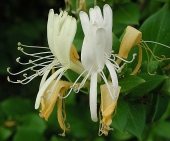These are some mediterranean edible flowers that grow in our forest garden and end up in our plates:
 Calendula (Calendula officinalis)
Calendula (Calendula officinalis)
We sprinkle the petals (the only part that is edible) in soups, roasted vegetables and salads, but they can be used in pasta, rice, scrambled eggs and herb butter.
Its medicinal properties are known to treat menstrual cramps, sore throat, cancer, ulcers, measles, smallpox and jaundice.
 Nasturtiums (Tropaeolum majus)
Nasturtiums (Tropaeolum majus)
This is our favorite edible flower.
We use the entire flowers to garnish platters, salads, and savory appetizers or stir fry.
Nasturtium contains 130 milligrams of vitamin C per 100 grams — and 45 milligrams of lutein, which is the highest amount found in any edible plant.
Lutein is anti-inflammatory and known to protect against eye disorders, cancer, diabetes and heart disease.
 Honeysuckle (Lonicera japonica)
Honeysuckle (Lonicera japonica)
Honeysuckle flowers have a honey flavor and we love them mainly in salads.
To alleviate headache – brew honeysuckle tea using the buds and flowers.
 Scented Geraniums (Pelargonium species)
Scented Geraniums (Pelargonium species)
Our favorite is the lemon-scented geranium with its lemon-scented flowers.
We sprinkle these edible flowers over desserts and in refreshing drinks or freeze in ice cubes.
 Yucca (Yucca filamentosa)
Yucca (Yucca filamentosa)
The white Yucca flower petals are crunchy with a mildly sweet taste (it has a hint of artichoke to it).
We use them in salads and as a garnish.
 Alliums
Alliums
Chives, garlic, leeks, onions and shallots – all have edible flowers.
The flowers have a stronger flavor than the leaves and the young seed-heads are even stronger.
We eat the flowers and seed-heads mainly in salads or omelettes.
All alliums contain chemical compounds which have anti-inflammatory, anti-oxidant and cholesterol lowering properties.
 Basil (Ocimum basilicum)
Basil (Ocimum basilicum)
We sprinkle them over salad and to flavor olive oil (blending olive oil and basil flowers and pouring over fresh tomato salad).
 Sage (Salvia officinalis)
Sage (Salvia officinalis)
We use the blue/purple flowers with beans, corn dishes, sauteed or stuffed mushrooms, or pesto sauce.
 Lavender (Lavandula angustifolia)
Lavender (Lavandula angustifolia)
Flowers look beautiful and taste good in a glass of champagne, with chocolate cake, or as a garnish for sorbets or ice creams.
We use lavender mainly to flavor teas and salad dressings.
 Courgette, Pumpkin and Squash (Cucurbita cvs)
Courgette, Pumpkin and Squash (Cucurbita cvs)
These delicious edible flowers can be eaten raw, on pizza, in a tomato sauce, battered and fried, stuffed with cooked rice, cheese, nuts or meat or used to make a delicious soup.
Use male flowers once the females are pollinated so you don’t reduce your yield.
I’d love to learn from you…
What mediterranean edible flowers grow in your own garden or food forest?
And...
what special ways do you use these edible flowers in your meals?
Thank you!










